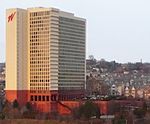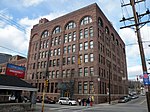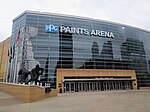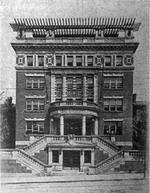The Civic Arena, formerly the Civic Auditorium and later Mellon Arena, was an arena located in Downtown Pittsburgh, Pennsylvania. The Civic Arena primarily served as the home to the Pittsburgh Penguins, the city's National Hockey League (NHL) franchise, from 1967 to 2010.Constructed in 1961 for use by the Pittsburgh Civic Light Opera (CLO), it was the brainchild of department store owner Edgar J. Kaufmann. It was the first retractable roof major-sports venue in the world, covering 170,000 square feet (16,000 m2), constructed with nearly 3,000 tons of Pittsburgh steel and supported solely by a massive 260-foot-long (79 m) cantilevered arm on the exterior. Even though it was designed and engineered as a retractable-roof dome, the operating cost and repairs to the hydraulic jacks halted all full retractions after 1995, and the roof stayed permanently closed after 2001. The first roof opening was during a July 4, 1962, Carol Burnett show to which she exclaimed "Ladies and Gentlemen ... I present the sky!"The Civic Arena hosted numerous concerts, the circus, political and religious rallies, roller derbies as well as contests in hockey, basketball, fish tournament weigh-ins, pro tennis, boxing, wrestling, lacrosse, football, ice skating championships, kennel shows, and soccer. The structure was used as the backdrop for several major Hollywood films, most prominently Sudden Death in 1995. Prior to its demise, it was known as Mellon Arena, named for Mellon Financial, specifically American businessman and 49th Secretary of the Treasury Andrew W. Mellon, which purchased the naming rights in 1999. Their naming rights expired on August 1, 2010, and the arena once again adopted the name of Civic Arena.The Civic Arena closed on June 26, 2010. The former Mellon naming rights expired soon after, and the Penguins and all other events moved across the street to the new Consol Energy Center – now PPG Paints Arena. After various groups declined historic status for the venue, it was demolished between September 2011 and March 2012. In its place, existing public parking lots in the area were expanded over the entire site. Two of the many streets stricken from the city's street plan when the arena was originally built were subsequently re-extended back through the site: Wylie Avenue and Fullerton Street. The Penguins have the rights to redevelop the property and a preliminary plan exists for residential units, retail space and office space.









